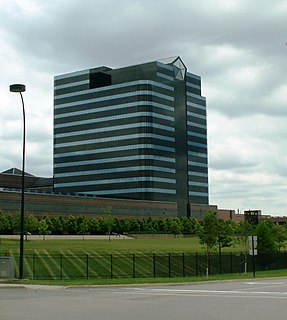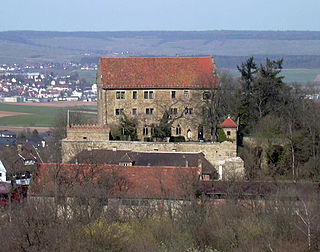
Chrysler is one of the "Big Three" automobile manufacturers in the United States, headquartered in Auburn Hills, Michigan. In addition to the Chrysler brand, Stellantis North America sells vehicles worldwide under the Dodge, Jeep, and Ram nameplates. It also includes Mopar, its automotive parts and accessories division, and SRT, its performance automobile division. The original Chrysler Corporation was founded in 1925 by Walter Chrysler from the remains of the Maxwell Motor Company. It was acquired by Daimler-Benz, which renamed itself DaimlerChrysler, in 1998. After Daimler divested Chrysler in 2007, the company existed as Chrysler LLC (2007–2009) and Chrysler Group LLC (2009–2014) before being acquired by Fiat S.p.A. and becoming a subsidiary of the newly-formed Fiat Chrysler Automobiles in 2014. Chrysler is a subsidiary of Stellantis, the company formed from the merger between FCA and Groupe PSA, since 2021.
Fiat S.p.A., or Fabbrica Italiana Automobili Torino, was an Italian holding company whose original and core activities were in the automotive industry, and that was succeeded by Fiat Chrysler Automobiles NV (FCA). The Fiat Group contained many brands such as Ferrari, Maserati, Fiat, Alfa Romeo, the Chrysler Group, and many more. On 29 January 2014, it was announced that Fiat S.p.A. was to be merged into a new Netherlands-based holding company Fiat Chrysler Automobiles NV (FCA), taking place before the end of 2014. Fiat Chrysler Automobiles became the new owner of Fiat Group. On 1 August 2014, Fiat S.p.A. received necessary shareholder approval to proceed with the merger. The merger became effective 12 October 2014.

Heilbronn is a city in northern Baden-Württemberg, Germany. It is surrounded by Heilbronn District and, with approximately 123,000 residents, it is the sixth-largest city in the state.
Tata Motors Limited is an Indian multinational automotive manufacturing company headquartered in Mumbai, Maharashtra, India. It is a part of Tata Group, an Indian conglomerate. Its products include passenger cars, trucks, vans, coaches, buses, sports cars, construction equipment and military vehicles.

Weinsberg is a town in the north of the German state Baden-Württemberg. It was founded around 1200 and is situated in the Heilbronn district. The town has about 11,800 inhabitants. It is noted for its wine.

NSU-Fiat was a German automobile manufacturer which produced Fiat vehicles under license at a plant acquired from NSU in Heilbronn from 1929 to 1957.

Tofaş is a Turkish automaker which was established in 1968 by Vehbi Koç, who was the founder of Koç Holding, based in Bursa, where the manufacturing plant of the company is located. It is jointly owned by Stellantis and Koç Holding.

The Sulm is a river in the Heilbronn district of Baden-Württemberg, Germany. It is an unnavigable right tributary of the Neckar. It rises in the Löwenstein Mountains and after 26.3 kilometres (16.3 mi) distance and 315 metres (1,033 ft) elevation drop flows into the Neckar at Bad Friedrichshall, near Untereisesheim and Neckarsulm. Its valley together with its tributary valleys is also known as the Weinsberg Valley, after Weinsberg, which is located there. The medieval region of Sulmgau, as well as the city of Neckarsulm, were named for it. The upper valley of the Sulm is a protected area.

Abstatt (help·info) is a municipality in the district of Heilbronn in Baden-Württemberg in southern Germany.

Cleebronn (help·info) is a municipality in the district of Heilbronn in Baden-Württemberg in southern Germany.

Flein (help·info) is a municipality in the district of Heilbronn in Baden-Württemberg in southern Germany.

Pfaffenhofen (help·info) is a municipality in the district of Heilbronn in Baden-Württemberg in Germany.

Fiat Automobiles S.p.A. is an Italian automobile manufacturer, a subsidiary of Stellantis. Fiat Automobiles was formed in January 2007 when Fiat S.p.A. reorganized its automobile business, and traces its history back to 1899 when the first Fiat automobile, the Fiat 4 HP, was produced.
The automotive industry crisis of 2008–2010 was a part of the financial crisis of 2007–2008 and the resulting Great Recession. The crisis affected European and Asian automobile manufacturers, but it was primarily felt in the American automobile manufacturing industry. The downturn also affected Canada by virtue of the Automotive Products Trade Agreement.

The Crailsheim–Heilbronn railway is a double-tracked, main line railway in southwest Germany that runs from Heilbronn, crossing the Hohenlohe region.
Transporter Industry International is a worldwide operating conglomerate of companies providing heavy-duty transport vehicles and related services. Its history goes back to Otto Rettenmaier's acquisition of Scheuerle Fahrzeugfabrik in 1988. In 1995, Nicolas Industrie joined the group, followed by Kamag Transporttechnik in 2004 and TII India, which is represented by the brand Tiiger, in 2015. Transporter Industry International is the global market leader and known for transports on behalf of NASA, for example.
Richard Drauz (help·info) was a Nazi German politician and Kreisleiter of Heilbronn, Germany. He was also Member of the Reichstag from 1933 until the collapse of the Third Reich after World War II. One of the most fanatical and violent NSDAP leaders in the last days of the war, Drauz was put on trial and executed by American occupation forces for war crimes in 1946.
The NSU/Fiat Weinsberg 500 is a Fiat automobile. It was produced in two versions based on the Fiat 500 (1957–1977). Like the Neckar Pully, the Weinsberg was the creation of NSU/FIAT Karosseriewerke Weinsberg, made possible because NSU/FIAT in Heilbronn also had its own development department, in which designers such as Antonio Fessia worked. Introduced in March 1959 as the NSU/Fiat, 6,228 vehicles were manufactured from 1959 to 1963. The price was 3,840 DM in 1959, 3620DM in 1962.
The automotive industry in Ireland has had a varied history and despite the small size of the island, the punitive tax on imported cars encouraged a wide range of companies to assemble their cars locally including Fiat, Ford and Renault. From Ireland's entry to the European Union in 1973, the need for locally produced cars to avoid import taxes reduced and since the 1980s, production ended and all cars are now imported.

The Heilbronn Stadtbahn is a three line tram-train system in city of Heilbronn in the German state of Baden-Württemberg. It is based on the Karlsruhe model and operated jointly by the Albtal-Verkehrs-Gesellschaft (AVG), the Stadtwerke Heilbronn (SWH) and Deutsche Bahn (DB). It operates on normal railways under the Eisenbahn-Bau- und Betriebsordnung and within Heilbronn under the Verordnung über den Bau und Betrieb der Straßenbahnen.
















